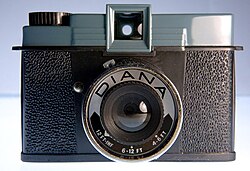Diana camera
From Wikipedia, the free encyclopedia
| This article includes a list of references or external links, but its sources remain unclear because it lacks inline citations. Please improve this article by introducing more precise citations where appropriate. (May 2008) |
| This article's citation style may be unclear. The references used may be clearer with a different or consistent style of citation, footnoting, or external linking. |
The Diana camera is a simple, low-quality plastic-bodied box camera. The Diana takes sixteen 4 × 4 cm pictures on 120 film, leaving a large part of the film surface unused. Though often referred to as a toy camera, the term is misleading, as the Diana takes regular photographs. The term "toy camera" is often used to denote a very simple camera, and includes various basic vintage cameras as well. It is widely considered as an ideological predecessor of the 1980s Holga. Dianas are said to have a 50 % chance of light leaks & other photographic problems. In the context of the Diana, though, these qualities give such photos taken by the camera an individualistic character.
The Diana was first produced during the early 1960s in Kowloon, Hong Kong, by the "Great Wall Plastic Factory", and was sold under various labels (often just a different stick-on nametag). Most were given away as novelties or prizes at fairs, carnivals, or other public events. In addition to the 'Diana' labeled cameras, there are over fifty similar variants of the basic design, some of which may have been produced by other factories and/or manufacturers. Some variants incorporate a 6 × 6 cm negative size (like the Diana Deluxe), while others have provision for different controls or separate bulb flashes. The 3 aperture version of the classic Diana/Diana clone has apertures of f11 f13 & f19, and it takes 32 mm clip on filters. Shutter speed is usually 1/100th (for a crisp one) to 1/50th (for a slower one). The Diana Deluxe- f9 f16 & f22, and it takes a 46-49 mm step-up ring.
With the development of inexpensive, higher quality consumer cameras such as the Kodak Instamatic, demand for the Diana, even as a novelty gift, gradually disappeared. Production of the Diana, its clones (have 151 marked on the door latch like the original Diana), close copies and variants is believed to have stopped sometime during the 1970s, though similar 35mm box cameras were produced for many years thereafter by various companies in Hong Kong and Taiwan as promotional items.
Diana cameras are predisposed to light leaks, a situation often remedied by sealing the seams with light-proof tape (like black electrical tape) after loading the film. To get the completed roll out of the camera, it is necessary to untape the body -- a ponderous but very useful procedure, as it helps to prevent a lot of unpredictable orange light streaks on the negatives/prints. The design of the Diana incorporates a lens that produces an image circle which only marginally covers the diagonal of a film frame. This marginal coverage field produces images with often pronounced vignetting. The poor quality of the plastic meniscus lens results in generally low contrast, odd color rendition, chromatic aberration, and blurred images. Although these attributes are generally thought undesirable in a camera, some photographers have intentionally utilized these characteristics to produce photographs with interesting or artistic effects, led prominently by American Nancy Rexroth in her highly-influential 1976 series "IOWA," in which she claimed to have made many of the photographs with her eyes closed and none of them in the physical state of Iowa.
Though made by a different manufacturer, the Holga camera is sometimes considered to be in the same family as the Diana. The Diana allegedly has more problems and quirks than the Holga. Some prefer Diana cameras, some prefer Holgas...some share the love and enjoy them both.
Remakes of the Diana are currently produced by Lomography and sell online or at retail stores worldwide.
[edit] Other Features
- The plastic body of the camera does not securely close, allowing light to leak into the camera.
- Some taping suggested to avoid excess light leaks.
- Spool may become loose or out of place when clicking the shutter release button.
- Not all images are guaranteed to be exposed properly or good in quality.
Keep in mind that black electrical tape can leave residue; gaffer tape, used by professionals in many industries, may provide better results.
[edit] References
- Tokina http://www.tokina.com.hk/
- Barnes, Mike. The Diana Legacy. ToyCamera.com. Retrieved on November 1, 2005.
- Labrouillère, Pascal. Diana camera, Diana clones & Photo Gallery
[edit] External links
- Detrich Collection A collection of over 150 classic Diana cameras.
- Images from Rexroth's IOWA
- Images taken with Diana camera
- Information about and images of Diana Cameras
- Diana Camera Gallery



